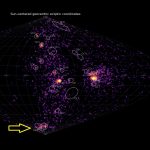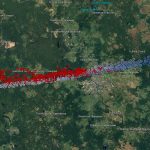
Introduction
It was already 11 years ago (2007) when I had clear and stable weather around a Leonid maximum! The grumbling of me in the Orionid report 2017 in eRadiant (“where are the Scandinavian high pressure areas?”) has apparently helped: since April it is a coming and going of high pressure areas above Northern Europe, resulting in good weather conditions throughout 2018.
As early as around November 10, there were signs that the weather in the Netherlands between 15 and 19 November would be very favorable for visual observations. Well, it didn’t quite work out that way, but hey, I could observe three nights in a row!
15/16 November 2018
I had to work on Friday so I planned a session a little earlier in the night than usual. Observations were done from the “meteor-observatory platform” on the dormer of my roof. There I could observe between 23:50 and 02:50 UT. In the second and third hours, the sky got a bit hazy, resulting in lower lm (6.3 to 6.0) and SQMs (20.18 to 20.06). On the images the all sky camera took that night, it was clearly visible that haze and fog increased after 02:50 UT and after 4:00 UT the sky was completely clouded out.
But what a nice session: many meteors and a lot of bright ones. In total I counted in t.eff. 3.00 hours effectively 45 meteors amongst them 4 Leonids and 11 Taurids.
The most spectacular meteors:
- 00:32 UT: orange magnitude -1 Taurid with -2 end flare in Monoceros. Captured with the all sky camera.
- 00:50 UT: the first meteor after this time is a very slow meteor of magn. +3 straight through Perseus. The meteor also shows a wake. Coming roughly from in the northern Pisces and Andromeda area. Would it have been an Andromedid?
- 01:03 UT: -1 SPO with 3 seconds persistent train moving from Taurus to Cetus. I classified the meteor as a Leonid, but from CAMS observations it turned out to be an sporadic meteor. The radiant was located in the northern part of Hydra and is therefore also in line with the Leonid radiant. The all sky camera also caught this meteor.
- 01:33 UT: -1 sporadic meteor in Eridanus to Orion
02:11 UT: a brilliant -3 Taurid which moved nice and steady through Perseus. Also captured with the all sky camera. - 02:37 UT: +1 Taurid from Taurus to Cetus.
 Figure 1. Crop of an all sky image with a Taurid of magnitude -2 or -3 in Perseus on November 16, 2018 at 02:11 UT. Camera: Canon 6D. Lens: Sigma 8 mm F 3.5 fish eye lens. The Liquid Crystal Shutter was set to 14 breaks per second.
Figure 1. Crop of an all sky image with a Taurid of magnitude -2 or -3 in Perseus on November 16, 2018 at 02:11 UT. Camera: Canon 6D. Lens: Sigma 8 mm F 3.5 fish eye lens. The Liquid Crystal Shutter was set to 14 breaks per second.
16/17 November 2018
Fortunately, I had a lot of overtime at work and when on Wednesday still a clear night 16/17 November was expected, I took a day off on Saturday morning November 17. So, I could observe nicely until the morning twilight (otherwise I had to stop at 02:50 UT). In the afternoon the sky cleared up more and more, although there was a bit of haze the first hours. But after a short sleep in the evening, the sky turned out to be pretty bright! I quickly cycled to the Groevenbeekse Heide (a heath field) and at 01:10 UT the observations started. The SQM was at 1:43 UT at 20.43 but rose a bit further to a nice 20.48. Not a top sky (I have ever reached 20.62 at this location), but very good. Of course, and as expected, this night gave nice numbers of meteors and again some bright ones too.
I could observe between 01:10 and 05:30 UT. There was a weak eastern wind which decreased over the period. The last hour there was some very thin haze that appeared above the heath. Lm first 6.4, the last hour 6.3. In total I counted in effectively 4.22 hours 82 meteors including a disappointing number of only 13 Leonids, 11 Taurids and 2 AMO. Another very slow meteor was seen of +2 with a long wake, again from the surroundings of the Northern Pisces and Andromeda. As said, the numbers of Leonids were disappointing with hourly counts of respectively 2, 2, 3 and 6.
The bright meteors:
- 01:26 UT: the session only lasted 16 minutes when a nice -4 Leonid appeared in Gemini with a persistent train of 6 seconds. The meteor was also beautifully captured with the all sky camera.
- 02:11 UT: WOW, a beautiful Taurid with three short flares at the end. I estimated the brightest flare at magnitude -4. This meteor was also beautifully recorded with the all sky camera.
- 03:20 UT: a beautiful orange 0 Taurid moved just under the star Betelgeuse.
 Figure 2. Leonid of magnitude -4 in Gemini on November 17, 2018 at 01:26 UT. Camera: Canon 6D. Lens: Sigma 8 mm F 3.5 fish eye lens. The Liquid Crystal Shutter was set at 30 breaks per second.
Figure 2. Leonid of magnitude -4 in Gemini on November 17, 2018 at 01:26 UT. Camera: Canon 6D. Lens: Sigma 8 mm F 3.5 fish eye lens. The Liquid Crystal Shutter was set at 30 breaks per second.
 Figure 3. Beautiful Taurid with multiple flares up to magnitude -4 on November 17, 2018 at 02:11 UT. Camera: Canon 6D. Lens: Sigma 8 mm F 3.5 fish eye lens. The Liquid Crystal Shutter was set at 30 breaks per second.
Figure 3. Beautiful Taurid with multiple flares up to magnitude -4 on November 17, 2018 at 02:11 UT. Camera: Canon 6D. Lens: Sigma 8 mm F 3.5 fish eye lens. The Liquid Crystal Shutter was set at 30 breaks per second.
In addition to the meteors mentioned, a few +1 Leonids were also seen. The temperature de-creased during this session from -1 to -3 degrees C at ground level. A very successful session!
17/18 November 2018
After the successful previous night we got a third night on a row with a clear sky! There was a fast eastern wind blowing so it would be a very cold session. The maximum of the Leonids was expected in the evening of 17 November. I started my observations at 00:48 UT and I managed to observe until 05:37 UT. There was a crystal-clear sky during the first three hours with the lm around 6.4 and SQM touching 20.53! However, during the fourth period there was very thin cirrus moving in from the east which caused the lm to drop slightly. That did not much affect the night sky. But during the last period 04:54 to 05:37 UT, more thick cirrus moved in from the northeast. The cirrus caused the lm to drop to an average of 6.1 and the sky obstruction F was 1.18.
In total I counted in 4.72 hours of effective time exactly 100 meteors, of which 35 were Leonids, 11 Taurids and 4 alpha Monocerotids. The Taurids only showed weak meteors this night. The bright meteors:
- After a few +1, +2 Leonids the first real beautiful meteor was seen at:
- 02:56 UT: a 0 magnitude Leonid in the north.
- 03:46 UT: a -2 Leonid moving from Gemini to Orion. This meteor was also observed by Michel Vandeputte from Ronse, Belgium.
- 05:13 UT: a nice -1 Leonid in Virgo, persistent train 3 seconds.
All in all fewer spectacular meteors than in the previous night, but definitely a successful session. The temperatures dropped from -2 to -5 Celsius with a moderate eastern wind.
The night 18/19 November was cloudy from 20:00 UT in Ermelo. That is very unfortunate because quite a few bright meteors and fireballs were reported this night (visually by Michel Vandeputte and by Felix Verbelen via radio). But, all in all, I am very satisfied and happy with the result! For the first time since 2007, I could observe a lot again during the Leonids. Hopefully I do not have to wait another 11 years.
All sky camera EN-98 in November 2018.
The all sky camera also scored extremely well in November, not less than 19 meteors were record-ed, see also table 1. The best hits were a slow -6 sporadic meteor on 6 November, a -6 Leonid on 20 November and a sporadic fireball on 30 November.

Figure 4. Slow sporadic meteor on 6 November 2018 at 02:44:55 UT. Camera: Canon 6D. Lens: Sigma 8 mm F 3.5 fish eye lens. The Liquid Crystal Shutter set at 14 breaks per second.
 Figure 5. Leonid fireball of magnitude -6 moving from Perseus to Triangulum on November 20, 2018 at 01:45:18 UT. Camera: Canon 6D. Lens: Sigma 8 mm F 3.5 fish eye lens. The Liquid Crystal Shutter was set at 30 breaks per second.
Figure 5. Leonid fireball of magnitude -6 moving from Perseus to Triangulum on November 20, 2018 at 01:45:18 UT. Camera: Canon 6D. Lens: Sigma 8 mm F 3.5 fish eye lens. The Liquid Crystal Shutter was set at 30 breaks per second.

Figure 6. The beautiful sporadic fireball of November 30, 2018 at 23:35 UT moving from Cancer to Hydra. Camera: Canon 6D. Lens: Sigma 8 mm F 3.5 fish eye lens. The Liquid Crystal Shutter was set at 10 breaks per second.






